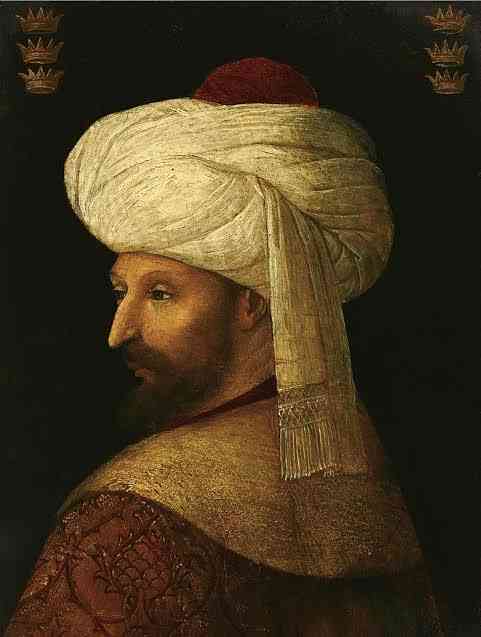Osmanlı İmparatorluğu’nun yedinci padişahı olan Fatih Sultan Mehmed (II. Mehmed), 1444-1446 ve 1451-1481 yılları arasında iki farklı dönemde tahtta bulunmuştur. Henüz 21 yaşındayken İstanbul’un fethi ile tarihin akışını değiştiren Fatih Sultan Mehmed, yalnızca bir asker değil aynı zamanda bir yönetici, bilim insanı ve sanat koruyucusuydu. Onun liderliği Osmanlı İmparatorluğu’nun altın çağına giden yolu açmıştır. Şimdi, Fatih Sultan Mehmed’in hayatını detaylı şekilde inceleyelim.
Fatih Sultan Mehmed, also known as Mehmed the Conqueror, was the seventh Sultan of the Ottoman Empire, ruling during two separate periods: 1444-1446 and 1451-1481. Born on March 30, 1432, in Edirne, he was the son of Sultan Murad II and Hüma Hatun. His reign is most famously marked by the conquest of Constantinople in 1453, an event that earned him the title "Conqueror" and established the Ottoman Empire as a global power. Beyond his military achievements, Fatih Sultan Mehmed was a visionary leader, fostering advancements in governance, science, and the arts.
Early Life and Background
Birth and Lineage
Born in Edirne, Fatih Sultan Mehmed came from a lineage deeply rooted in leadership and conquest. His father, Sultan Murad II, was an accomplished ruler who expanded Ottoman territories, while his mother, Hüma Hatun, was a woman of noble origins. Mehmed was the third son, but his exceptional intelligence and ambition set him apart from his siblings.
Education and Training
From an early age, Mehmed was provided with a rigorous education. His tutors included prominent scholars who taught him Islamic theology, governance, military strategy, and multiple languages, including Arabic, Persian, Latin, and Greek. This broad education made him a polymath, capable of engaging with diverse cultures and ideas.
Governorship in Manisa
As a prince, Mehmed was appointed governor of Manisa, a critical training ground for Ottoman heirs. Here, he gained firsthand experience in administration and military command, preparing him for his future role as Sultan.
Impact of Early Abdication
In 1444, Mehmed briefly ascended the throne after his father’s abdication but faced internal and external pressures, including the Crusade of Varna. This period shaped his understanding of leadership and resilience.
Reassumption of Power in 1451
Upon his father’s death in 1451, Mehmed once again took the throne, this time with a clear vision to consolidate and expand the Ottoman Empire.
The Conquest of Constantinople
Strategic Importance of Constantinople
The city of Constantinople, strategically located between Europe and Asia, was a symbol of wealth and power. Its capture was a long-standing ambition for the Ottomans, and Mehmed was determined to achieve this goal.
Preparation for the Siege
Mehmed meticulously planned the siege of Constantinople. He commissioned the construction of the massive Rumeli Hisarı fortress, ensuring control over the Bosporus Strait, and developed advanced siege weaponry, including the giant cannon designed by the engineer Urban.
The Siege and Victory
On May 29, 1453, after a 53-day siege, Fatih Sultan Mehmed successfully captured Constantinople. This victory marked the end of the Byzantine Empire and the beginning of a new era for the Ottoman Empire, solidifying Mehmed’s reputation as a visionary conqueror.
Transformation into Istanbul
Following the conquest, Mehmed transformed Constantinople into Istanbul, the new capital of the Ottoman Empire. He initiated extensive rebuilding efforts, including the construction of mosques, markets, and educational institutions.
Global Reaction to the Conquest
The fall of Constantinople sent shockwaves across Europe and Asia. Mehmed’s achievement elevated the Ottomans to a dominant position on the global stage, earning him both admiration and fear.
Military Campaigns and Governance
Expansion into Europe and Asia
Fatih Sultan Mehmed extended Ottoman territories through campaigns in the Balkans, Anatolia, and the Black Sea region. He subdued Serbia, Bosnia, and Albania, while also consolidating control over the Anatolian beyliks.
Naval Expeditions
Recognizing the importance of naval power, Mehmed strengthened the Ottoman navy. His campaigns in the Aegean and the Mediterranean established Ottoman dominance over key maritime trade routes.
Legal and Administrative Reforms
Mehmed restructured the empire’s legal and administrative systems, ensuring justice and efficiency. He codified laws that balanced Islamic principles with practical governance.
Cultural Patronage
A patron of the arts and sciences, Mehmed invited scholars, artists, and architects from across the world to his court. He commissioned the construction of monumental works such as the Topkapı Palace.
Legacy of Tolerance
Mehmed’s policies promoted coexistence among the empire’s diverse populations, fostering a multicultural environment that became a hallmark of the Ottoman state.
Legacy and Death
Cultural and Scientific Contributions
Fatih Sultan Mehmed was a renaissance figure, promoting the translation of classical texts and the advancement of knowledge. His court became a hub of intellectual and artistic activity.
Impact on Future Generations
Mehmed’s achievements laid the foundation for the Ottoman Empire’s golden age under his successors. His vision and reforms influenced the empire for centuries.
The Mystery of His Death
Mehmed died on May 3, 1481, under mysterious circumstances. Some accounts suggest poisoning, though the exact cause remains unknown.
Historical Interpretations
Historians regard Fatih Sultan Mehmed as one of the greatest leaders in world history, comparing his achievements to those of Alexander the Great and Julius Caesar.
Lessons from His Reign
Mehmed’s reign demonstrates the importance of vision, determination, and cultural openness in achieving greatness.
Conclusion
"Fatih Sultan Mehmed (II. Mehmed) Biyografisi" başlığı altında, Osmanlı İmparatorluğu’nun yedinci padişahı olan Fatih Sultan Mehmed’in liderliği ve başarıları detaylı şekilde ele alınmıştır. İstanbul’un fethi, askeri reformları ve kültürel katkılarıyla, o sadece Osmanlı tarihini değil, dünya tarihini de şekillendirmiştir.
Summary: The Visionary Leader Who Conquered History
- Fatih Sultan Mehmed (1432-1481) was the seventh Ottoman Sultan, known for his conquest of Constantinople.
- His reign marked the transition of the Ottoman Empire into a global power.
- Mehmed’s military campaigns expanded the empire across Europe and Asia.
- He transformed Constantinople into Istanbul, the empire’s vibrant new capital.
- Mehmed’s patronage of the arts and sciences fostered a cultural renaissance.
- His administrative and legal reforms strengthened the empire’s governance.
- Historians regard him as one of the greatest leaders in history.
- His legacy continues to inspire as a model of visionary leadership and cultural integration.



